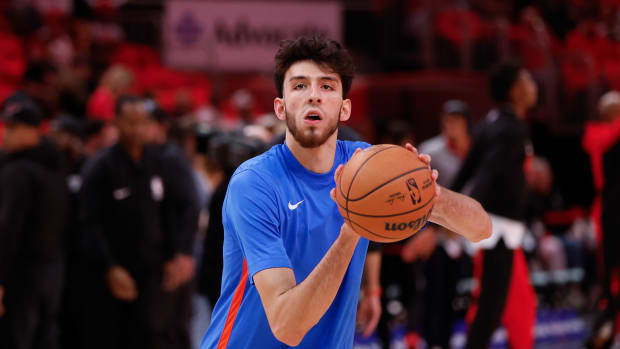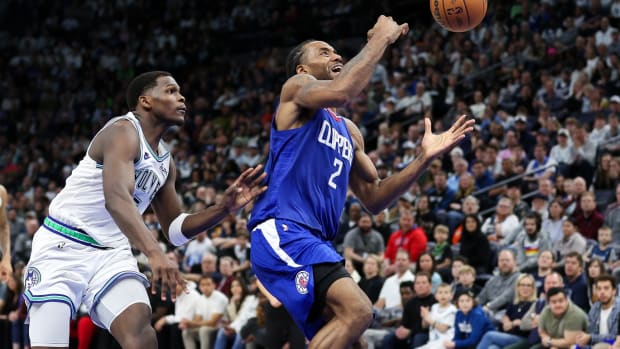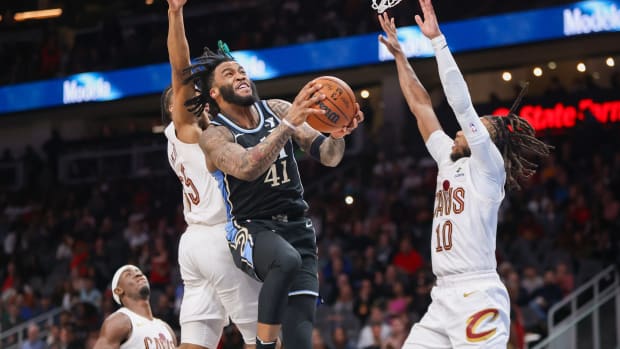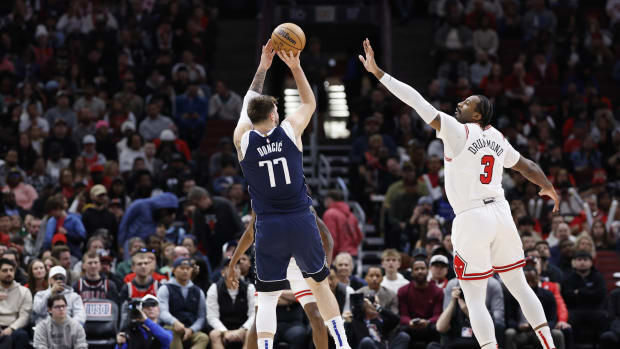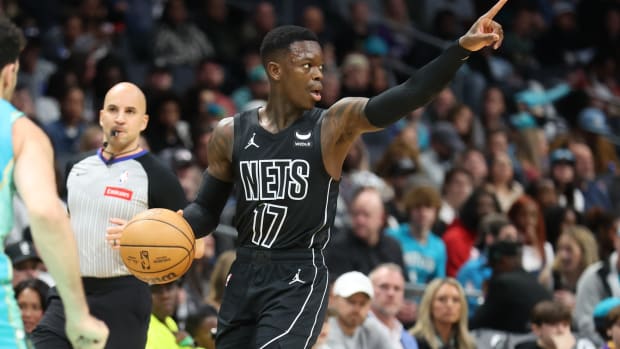
Court Vision: Phoenix Suns guard Eric Bledsoe, playmaker
Eric Bledsoe is off to an outstanding start with the Suns. (Barry Gossage/NBAE via Getty Images)
• Eric Bledsoe has begun his season in Phoenix by eclipsing even the most optimistic projections for his development, as he's flashed precisely the kind of shooting touch and playmaking ability that had seemed to elude him previously. Over at Hardwood Paroxysm, Jack Winter digs into the areas where Bledsoe has excelled most, including his aforementioned passing -- particularly in a slowed down, halfcourt setting:
But fast-breaks only come so often. Bledsoe’s growth extends to the halfcourt, too, where he’s shown the ability to consistently find shooters in the weak-side corner. That’s a skill limited to just certain types of ballhandlers, and though Bledsoe certainly has the physical makeup, there were concerns coming into the season that he’d never develop the mental acuity to make such plays. But he’s completely quelled them at this point in the season, frequently exhibiting pace control and manipulation of the defense that belies his experience level.
Just how good has Bledsoe been as a passer in 2013-2014? Though he ranks 10th in assists per game at 7.5, only John Wall’s dimes are more valuable. According to NBA.com’s player tracking data, Phoenix averages 2.44 points per Bledsoe assist, the second best mark in the league among the top 20 players in assists per game. The numbers behind the numbers support the eye-test, basically, and it all points to Bledsoe being one of basketball’s best playmakers.
• The D-League has long been a prime spot for basketball experimentation, and Grantland's Zach Lowe has the scoop on which subtle rule changes being test-driven at the D-League-level could eventually help to shorten the NBA game.
• "They killed Foghorn Leghorn...right in front of his teammates." Space Jam gets the (unofficial) 30 for 30 treatment.
• Among Atlanta's defensive problems thus far: The Hawks' bigs are playing a bit too far back in the pick-and-roll, giving opponents slightly too much room to launch up a clean mid-range jumper.
• As if Andrea Bargnani's play for New York weren't depressing enough, Mike Kurylo of Knickerblogger offers a sobering, Knicks-minded comparison between Bargs and a stylistic analogue:
I’ve noticed that Andrea Bargnani reminds me of Eddy Curry. Not only is there similarty in their games, both offensive minded centers who don’t rebound or defend well, but in the fans’ logic in defending them. Although most understood Bargnani’s limitation on the defensive end and on the glass, some felt his outside shooting would spread the floor opening things up in the center for the rest of the team. Certainly Bargnani’s ability to put the ball on the floor would make him more valuable to the Knicks than Steve Novak.
Unfortunately the addition of Bargnani hasn’t helped the team as expected by the rhetoricians. Prior to yesterday’s game, Andrea ranked 5th in minutes and the Knicks ranked 20th on offense. The Roman Candle’s failure to ignite might be linked to another shared trait with Eddy Curry: the lack of court vision.
• On a related note, Seth Rosenthal of Posting and Toasting lays out the myriad ways in which the Knicks invited their own demise on Saturday, when the Spurs dropped the hammer with a 120-89 demolition:
If you make a defensive switch, then the switched defenders will probably be mismatched. If you are dissatisfied with those mismatches such that you feel it is necessary to double, perhaps you shouldn't have switched. If you double the guy with the ball, then someone without the ball is open. If that open person without the ball is Danny Green behind the arc and no one is around to close him out, then perhaps you shouldn't have doubled. If you play lineups with players that don't space the floor, there probably won't be much space on the floor. If Carmelo Anthony is doubled and you don't get the ball to the weak side of the floor, then you will probably not get a good shot. If a guy attacks you with a knife and you lift your shirt and point to your belly, you're going to get stabbed in the belly.
• Houston, on the whole, attempts a greater percentage of its shots inside when not playing Dwight Howard and Omer Asik together. This is the kind of overarching effect that's being discussed under the guise of spacing, as in cases like these we find that teams with two short-range bigs clog up the court to destructive effect. As much as one might think that having two big men to run pick-and-rolls and periodically post up might bring a team's offense closer to the hoop, there's a diminishing return in piling up players with similar scoring skill sets.
• With a little CGI help, Asik is a really impressive ball handlerlaptop handler.
• Among the more compelling league-wide trends thus far: a dramatic increase in pace across the board. Kevin Pelton explains -- in analyzing all manner of trends in this young NBA season -- for ESPN.com Insider ($):
This is the fastest start the NBA has had in decades. The league-wide pace is up from 90.7 possessions per 48 minutes to 94.0, which would be the NBA's high-water mark since 1992-93. This trend doesn't look like a fluke. Historically, pace of play changes little after the end of the season's first month.
Explaining the league's up-tempo shift is challenging. While a handful of new coaches are pushing the pace -- most notably Brett Brown, whose 76ers rank third with 98.4 possessions per 48 minutes -- on average, teams that kept their coaches have sped up a bit more (plus-3.6 possessions per 48) than those that changed them (plus-2.9). The shift also is is remarkably uniform, with 27 of the NBA's 30 teams playing faster than they did last season.
Paul Flannery's rundown of the NBA's chief victims of circumstance































